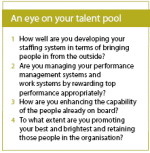Personnel Decisions International: The Talent Game
Far too many companies are failing to manage their talent because their human resources are not sophisticated enough for the modern marketplace. Brian Davis, executive vice president of Personnel Decisions International, tells Steve Coomber how to win at the talent game.
Organisations are beginning to understand that paying attention to their human capital is essential if they are to remain competitive. Yet they still have some way to go and some difficult challenges to face before they can be confident of dealing with human capital as effectively as they do finance, marketing or other corporate functions.
Brian Davis, executive vice president of Personnel Decisions International (PDI), a leading human resources consulting firm, believes that for organisations to be successful, they need to compete in three markets.
'They need to compete for financial capital to get the funding they need in order to implement their organisational strategy, for customers in the consumer market and employees in the human capital market.'
'I think companies are attending to the human capital strategy element, but the level of sophistication is way behind other areas, such as finance and marketing.'
DEVELOPING SOPHISTICATION
Perhaps it is no surprise that organisations are struggling with human capital management. The sales profession is centuries old, although it wasn't until the early 1900s that companies began to develop a distinct marketing function and think about segmenting customers and treating those segments differently. A decision science developed around customer segmentation, and then the strategic pursuit of those different segments.
Similarly, in the financial world, double entry bookkeeping was invented by Luca Pacioli in 1494, yet it was not until the late 19th and early 20th century that cost accounting was refined and the discipline of finance developed, focusing on the decision-making and decision models for managing financial capital.
Davis believes that business is undergoing a similar evolution in human resources: 'Not all that long ago, human resources didn't exist. The personnel function was created out of the purchasing function, as the people who used to purchase raw materials were also responsible for purchasing labour.
'Then there was a recognition that people were a little different from raw materials, and this led to the creation of a personnel function. Then, probably 30 or 40 years ago, human resources emerged as a more sophisticated way of looking at human resources, and being more strategic about that.'
'The next step on that evolutionary process, of making it a true decision science, is what we call talentship.'
ATTRACTING TALENT
Talentship is about looking at organisational strategy and then determining the 'pivot points' in the organisation, viewed from a talent perspective.
Davis explains: 'You think about how you are going to compete in the marketplace, asking what particular talent pools you need to improve in order to win in the marketplace.
'So, just as companies segment different market segments to go after, companies now really need to focus on segmenting different talent pools – those where they are going to create competitive advantage.'
It is quite a contentious approach in that it advocates differential treatment of staff, depending on their status in terms of pivotal talent pools. Different talent pools will be treated in dramatically different ways.
DEFINING TALENT
What constitutes a pivotal talent pool? For example, Davis compares the people who play the Disney characters at Disneyworld with the sweepers. The role of the people playing the characters is fairly prescribed; there is limited scope for individual interpretation, with much of the variability engineered out. However, with the park sweepers, a big part of their role is unrelated to sweeping, and instead involves identifying when guests are having problems and making sure that the quality of their experience improves.
The park sweepers, then, are a pivotal talent pool in relation to ensuring that visitors have a great experience in the theme park – a key strategic objective for Disney. The park sweepers are pivotal, says Davis, because significant improvements in their performance have a dramatic impact on the stay for guests.
So the first step in getting talentship right is identifying the critical strategic drivers in the organisation and assessing the talent needs of the people connected to those drivers.
Davis says: 'We help our clients sort through which talent pools are going to make the biggest difference to the organisation's performance; this will usually involve interviews, perhaps even workshops with the senior executives.
'Then, once we have identified this talent pool, we look at what the organisation has to change the most to achieve its strategy. It might be that it needs more of a particular talent pool, which would then make it a quantity pivotal talent pool, or that it needs significantly better performers in that talent pool to make a difference.'
Then, once the talent that is really going to make a difference – the pivotal talent pools – has been identified, an organisation needs to systematically evaluate its different talent management systems.
MANAGING TALENT
When it comes to managing talent, Davis identifies four main systems to look at. First, it is vital to consider the extent to which the company is developing its staffing system in terms of how it is bringing people in from the outside. Second, performance management systems and work systems need to be assessed in terms of whether the company is managing them well; is it rewarding top performance appropriately? A third system is the company's development system; that is, how it enhances the capability of the people already on board. Finally, there is the organisation's succession management system and to what extent the company is promoting and retaining its best and brightest.
He explains: 'We see this as part of a talent management framework and, once you have identified the pivotal talent pools, that's when you systematically start looking at your talent management systems to see how you are going to increase the quality of talent in those pivotal talent pools.'
Evaluating existing talent is an essential part of the process, and Davis identifies a number of key factors when doing this: 'It is important to consider how an individual is performing in their current role, assessing the results they are achieving and what leadership behaviours they are exhibiting – so both the "what" and "how" of current performance.
'And just because they are a good performer in their current role, this doesn't mean that they are going to be a good performer in a more senior role, because there are new factors that come into play at those more senior levels.'
PROMOTING TALENT
Davis believes it is very important to consider a person's potential to move up a couple of levels, which can be measured through testing and asking probing questions.
He explains: 'A lot of organisations don't do a very good job of identifying potential because they rely totally on their managers or bosses to select people that have the potential to move up a couple of levels in the organisation. But they may have the wrong lens through which they view their people. It may be to do with how much they like them, whether they get along, whether or not they are good team players, rather than to do with their capabilities.'
Getting the appropriate talent management framework in place is not without its challenges. Davis says: 'Often organisations will adopt a one-size-fitsall approach to their talent pools. Some might call it the peanut butter approach, where they spread the same amount of peanut butter evenly across the slice of bread so everybody gets the same training and development, instead of focusing on the critical people.'
This stems from the fact that the roots of HR are to do with fairness, treating people equitably, giving them the same opportunities. Consequently, the notion that a company may favour one talent pool at the expense of another in terms of quality and extent of training, for example, is often unpalatable for organisations.
However, Davis says: 'If a company has scarce resources and a number of different talent pools, it needs them to be adequate enough, but, as an organisation, it is better off investing relatively more in the pivotal talent pool that is creating its competitive advantage.
'Organisations need to decide where they are going to compete, and then target resources at that human capital segment – in the majority of companies at the moment that is just not happening.'


